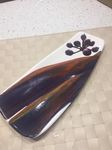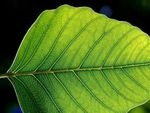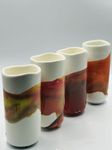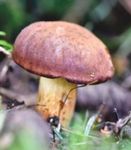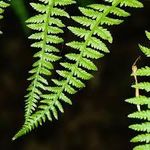A Biomimicry Study of Interface Design for Kitchenware of Pahang's National Park
←
→
Page content transcription
If your browser does not render page correctly, please read the page content below
International Journal of Research and Innovation in Social Science (IJRISS) |Volume V, Issue VI, June 2021|ISSN 2454-6186
A Biomimicry Study of Interface Design for
Kitchenware of Pahang’s National Park
Norfadilah Kamaruddin*, Noor Shamsarini Md Isa, Nik Nor Azidah Nik Aziz, Inda Murni Hairul
Anuar, Mohd Shariful Hafizal Aminuddin, and Fadli Abdul Razak
Creative Visual Exchange Group, Faculty of Art and Design, UniversitiTeknologi MARA (UiTM) Selangor, PuncakAlam
Campus, Puncak Alam, Selangor
Corresponding author*
Abstract: Sustainable design currently is becoming a more and philosophical aspects of this science have remained under
more popular and foreseeable perspective of viewing products. developed and descriptive(Mathews,2011).
Besides, a biomimicry is a science work that studies on nature’s
ways and then imitates these designs for human problem-solving. Therefore, in the Mother Nature of Pahang’s National Park,
Biomimicry moreover can be categories into three different there are limited number of biomimicry study conducted in
levels: Nature as a model, Nature as a measure, and Nature as a term of Nature as a mentor. In this paper, the principal focus
mentor. Thus, the research is carried out by using qualitative is the ability of the philosophical approach of biomimicry to
research methods to look on how nature’s masterpieces pattern aid in the finding of new techniques in nature for use in art
would be used as an interfaces for kitchenware product and design field. Thus, the inter-disciplinary research study
(ceramic) that further presenting a brand for Pahang’s National
Park. The kitchenware design is based on systematic analysis of
was carried out by looking at how nature’s masterpieces
local nature patterns collected from plants, fish, and flora within pattern would be used as an image for kitchenware product
the area of Kuala Keniam, Pahang’s National Park.This new set (ceramic) that further presenting a brand identity for Pahang’s
of design kitchenware product visibly significant defines the National Park.Furthermore, this study attempted to develop
relationship of nature, and can be applied to practical design to the intersection between natural design patterns and sciences,
enhance and support visual communication. and tried to combine natural patterns with the form design
Keywords: Nature; Pattern; Colour; Sustainable Design through scientific techniques that can be applied to practical
design to enhance and support visual communication.
I. INTRODUCTION
II. METHODOLOGY
A sustainable design from nature is becoming more
popular nowadays and a biomimicry is a science work
that studies nature’s ways and then imitates these designs for
Due to the limitations of existing methods in Art and Design
particularly on biomimicry study, this research project was
human problem-solving. Mostly, those work defined as used A Qualitative Analytical Frameworks. As this study
biomimicry is originated from applied science field that focus mainly focused on analyzingof colors and patterns from
on inspiration from the natural and opens avenues for animals, insects and plants (flora and fauna) found in
technological or sustainable design and innovation. For Pahang’s National Park from two different perspectives (Art
and Science), A Qualitative Analytical Frameworks was used
example, biomimicry suggests that study of nature can reveal
more sustainable solutions interms of efficient processes, through Qualitative Colour Pattern Analysis (QCPA)
functions, systems and materials. A Biomimicry study procedures (Figure 1) to assessing how animals, insects and
moreover can be categories into three different levels: Nature plants(flora and fauna) colour patterns appear against their
as a model, Nature as a measure, and Nature as a mentor. natural background as viewed by ecologically relevant
species.
Some researchers believe that these dimensions form the basis
for classifying the different approaches to biomimicry and
various numbers of study were conducted under biomimicry
as innovation.
A biomimicry have also been used interchangeably in recent
research nowadays. Biomimetics involved with artificial
mechanisms to produce materials similar to ones that exist
innature(Reap & Bras,2005). Reap & Bras also claimed that
biomimicryseeks resolving engineering problems using data
related to biological functions and primarily focused on
sustainability and imitates nature’s efficiency. Despite the
Figure 1: A Qualitative Color Pattern Analysis Framework
dominant role of biomimicry in the industrial sector, the
www.rsisinternational.org Page 67International Journal of Research and Innovation in Social Science (IJRISS) |Volume V, Issue VI, June 2021|ISSN 2454-6186
As the research is based on Keniam Trail in Pahang’s Table 1: Research Design
National Park, the sample of study were focusing only on the Design
Design Design
plants that were divided into four group: Ferns, Fungi, Leaves Activities Thinking
Processes (DP) Tools (DT)
and Fauna. The research design has involved in three aspects (DT)
(Table 1) : Design Thinking (DT), Design Processes (DP), and Line
Observation
Abstract Drawing
Design Tools (DT). This also leads to the design cognitive Sketches
Arts Thinking Graphic
model of designers and scientist in the product design process. Form and
Design
Colour
Prototype
Logic Physics
Science Algorithm
Thinking Calculation
The photograph images firstly were group according to the types and further were analyzed based on line drawing (Table 2).
Table 2: The types of plants in nature and group in line drawing
Types Ferns Fungi Leaves Fauna
In Nature
In line
Drawing
Colors
III. INNOVATION PROJECT OUTCOMES and can be effectively applied into form design (kitchenware).
This new set of design kitchenware product visibly significant
Ofthe29 sample of animals, insects and plants gained from
defines the relationship of nature, and can be applied to
Keniam Trail in Pahang’s National Park, a pattern and colour
practical design to enhance and support visual
tribulations are achieved by morphological imitation of
communication. Figure 2 shown an example of colours and
natural organisms’ patterns and colours. Moreover natural
pattern used on kitchenware product
patterns revealed have provided an unlimited source of design
www.rsisinternational.org Page 68International Journal of Research and Innovation in Social Science (IJRISS) |Volume V, Issue VI, June 2021|ISSN 2454-6186
Figure 2: Set of design kitchenware product
IV. CONCLUSION ACKNOWLEDGEMENT
The outcomes of this research have been a merging of This study is part of the 2nd Scientific Exploration at
aesthetics and science where finding on the science logic Pahang’s National Park which engaged researchers from
behind natural patterns has been a key step for the designers in University Teknologi MARA and The Department of Wildlife
proposing their new design work. The combination of and National Parks Peninsular Malaysia.
parametric natural patterns and colours will also open up new
REFERENCES
methods for designers and scientist to work together. In
which, designers are not only required to constantly update [1] Bohren (1988). Understanding colours in nature. 1(4):214-22.
their knowledge on design but also need to respect the logical https://doi: 10.1111/j.1600-0749.1988.tb00419.x.
[2] Chan, I.Z.W., Chang, J.J.M., Huang, D. & Todd, P.A. (2019).
science in environment. Similarly, scientists have required Colour pattern measurements successfully differentiate two cryptic
having a parametric aesthetic thinking on the generative Onchidiidae Rafinesque, 1815 species. Mar. Biodivers. 1–8.
system of design. In instance, this study also covered that Marine Biodiversity
natural patterns and colours has offered an unlimited source of [3] Endler, J.A., Cole, G.L. & Kranz, A.M. (2018). Boundary strength
analysis: Combining colour pattern geometry and coloured patch
design and can be effectively applied to form image brand. visual properties for use in predicting behaviour and fitness.
The findings from the study also contributing to the Methods Ecol. Evol. 9: 2334–2348.
Sustainable Development Goals (SDG) in environmental [4] Endler, J.A. & Mielke, P.P.W. (2005). Comparing entire colour
benefits, climate action and increased economic stability via patterns as birds see them. Biol. J. Linn. Soc. 86: 405–431.
[5] Hempel De Ibarra, N., Giurfa, M. &Vorobyev, M. (2002).
forest products. Importantly, giving special attention to how Discrimination of coloured patterns by honeybees through
plant in the forestry can provide a therapy through colours and chromatic and achromatic cues. J. Comp. Physiol. A Neuroethol.
patterns, this study not only shared the findings from two Sensory, Neural, Behav. Physiol. 188: 503–512.
perspectives but also helps in generating sustainable economic [6] Maia, R. & White, T.E. (2018). Comparing colors using visual
models. Behav. Ecol. 29: 649–659.
growth and society. [7] Mathews,F.(2011)TowardsaDeeperPhilosophyofBiomimicry,Orga
nization&Environment,24(4),364 -387.
[8] M Macnab, WB Fan (2013). Design by nature: using universal
forms and principles in design (China Machine Press, Beijing,
www.rsisinternational.org Page 69International Journal of Research and Innovation in Social Science (IJRISS) |Volume V, Issue VI, June 2021|ISSN 2454-6186
[9] Murphy, P. and Doherty, P. (1996). The Colour of Nature. [11] R Oxman, N Gu. (2015) . Theories and Models of Parametric
Chronicle Books, San Francisco, Ca. Design Thinking. eCAADe 33, 2, 477- 482
[10] Reap, J., Baumeister, D. and Bras, B.(2005) Holism, biomimicry [12] R Oxman. (2017). Thinking difference: Theories and models of
and sustainable engineering, In ASME 2005 International parametric design thinking. Design Studies, 52, 4-39
Mechanical Engineering Congress and Exposition, 423 - 431. [13] Shuichi Kinoshita and Shinya Yoshioka (2005). Structural Colours
Available from: in Nature: The Role of Regularity and Irregularity in the Structure.
https://www.researchgate.net/publication/321397939_Biomimicry 6(8):1442-59 https://doi.org/10.1002/cphc.200500007
_as_Innovation_a_systematic_review [accessed May 31 2021]. [14] Williams, E.H. (2005). The Nature Handbook. Oxford University
Press. New York, NY
www.rsisinternational.org Page 70You can also read




